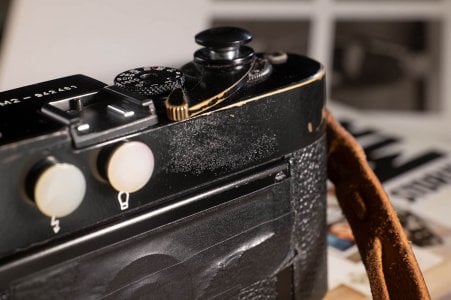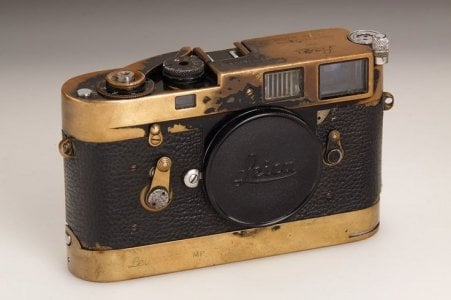John C. Ling
Member
I have an authentic black M2 which I bought many years ago. It was initially in poor cosmetic state but was completely restored by E Leitz in Rockleigh, New Jersey. It has remained in ‘as new’ condition since except for spontaneous development of bottom plate ‘onion-skinning’ which I have corrected to a large extent by judicious use of 5-0 steel wool. I wonder whether Leica still has the moral responsibility to correct this painting defect so many years later.Hello Everyone,
The M2 has original black paint and was never restored.
What is the best method for me to sell my camera?
Do you know anyone who buys cameras?
View attachment 4830802
Deardorff38
Mentor
Moral responsibility? The paint used on Leica M2 & M3 was imperfect....lots of them bubble, as in this photo. (it is one way to identify it as original black paint) As with other valued tools, (antique furniture & vintage guitars for example,) completely "restoring" devalues them. A lot of their aesthetic beauty comes from their wear by human hands. (Paul Fusco's MP)I have an authentic black M2 which I bought many years ago. It was initially in poor cosmetic state but was completely restored by E Leitz in Rockleigh, New Jersey. It has remained in ‘as new’ condition since except for spontaneous development of bottom plate ‘onion-skinning’ which I have corrected to a large extent by judicious use of 5-0 steel wool. I wonder whether Leica still has the moral responsibility to correct this painting defect so many years later.


Last edited:
John C. Ling
Member
Why was the black paint used by E. Leitz in the USA in their complete restoration in the past of my Leica M2 susceptible to ‘onion peeling’? I would have thought that by the mid 1970s that this deterioration possibility would have been eliminated. I don’t recall ever seeing this defect occurring in black body screwmount Leica camera bodies of the 1930s. I have several black Leitz microscopes of the 1920s and 1930s and their black finish look absolutely unblemished and almost new. Why is there a long-term problem with postwar black M bodies’ paint finish?Moral responsibility? The paint used on Leica M2 & M3 was imperfect....lots of them bubble, as in this photo. (it is one way to identify it as original black paint) As with other valued tools, (antique furniture & vintage guitars for example,) completely "restoring" devalues them. A lot of their aesthetic beauty comes from their wear by human hands. (Paul Fusco's MP)
View attachment 4830959
View attachment 4830960
Freakscene
Obscure member
My father worked for Leica in Australia in the 1950s and oversaw a lot of their service work. It is almost certain that Leitz in the US sent your camera to Germany. They also did not 'restore' your camera. They got blank new old stock black paint parts, added the serial to the top plate and other relevant parts of the camera, and put it back together. The new parts have the same paint on them that the old camera had, including that it is susceptible to wear and artefacts including bubbling and delamination.Why was the black paint used by E. Leitz in the USA in their complete restoration in the past of my Leica M2 susceptible to ‘onion peeling’? I would have thought that by the mid 1970s that this deterioration possibility would have been eliminated. I don’t recall ever seeing this defect occurring in black body screwmount Leica camera bodies of the 1930s. I have several black Leitz microscopes of the 1920s and 1930s and their black finish look absolutely unblemished and almost new. Why is there a long-term problem with postwar black M bodies’ paint finish?
Legally Leica have no requirement to support your camera after it is 10 years old, although this varies by country. Like companies, cameras don't have morals.
I had a very valuable Leica lens auctioned by Leica last year. It is the most secure and worthwhile approach. They have the best multi-country reach, so all collectors not under international sanctions (and a lot of those have workarounds) can bid. You lose some money on fees, but they buyer's premium covers most of the costs. Both you and the buyer are fully protected through the transaction. For something like a pristine black paint M2, it is by far the best approach. They have current and former Leica employees who verify the merchandise.
Marty
Last edited:
John C. Ling
Member
I’m sorry to have used the wrong descriptive term. I meant to say ‘orange skin pitting’, not ‘onion peeling’. I should have used the right fruit and not the wrong vegetable!My father worked for Leica in Australia in the 1950s and oversaw a lot of their service work. It is almost certain that Leitz in the US sent your camera to Germany. They also did not 'restore' your camera. They got blank new old stock black paint parts, added the serial to the top plate and other relevant parts of the camera, and put it back together. The new parts have the same paint on them that the old camera had, including that it is susceptible to wear and artefacts including bubbling and delamination.
Legally Leica have no requirement to support your camera after it is 10 years old, although this varies by country. Like companies, cameras don't have morals.
I had a very valuable Leica lens auctioned by Leica last year. It is the most secure and worthwhile approach. They have the best multi-country reach, so all collectors not under international sanctions (and a lot of those have workarounds) can bid. You lose some money on fees, but they buyer's premium covers most of the costs. Both you and the buyer are fully protected through the transaction. For something like a pristine black paint M2, it is by far the best approach. They have current and former Leica employees who verify the merchandise.
Marty
Freakscene
Obscure member
It doesn’t really matter; irrespective of their collectability, the black paint Leica used for the M2, 3 and 4 is a pretty ordinary finish for a camera. The MP paint, also used on a la carte and other modern black paint Ms is better. But all black paint Leicas really do look pretty.I’m sorry to have used the wrong descriptive term. I meant to say ‘orange skin pitting’, not ‘onion peeling’. I should have used the right fruit and not the wrong vegetable!
Last edited:
M2PHOTOS
Newbie
Sold thank you everyone! 
Richard G
Mentor
Interesting and invaluable expertise you’ve shown there Marty.
Last edited:
Erik van Straten
Mentor
What has always amazed me is that the quality of the black paint on the earliest Leicas (0, I, II and III) was much better than that of the Leicas M3, M2 and the early MP. Why wasn't the same paint used for the M Leicas?
santino
FSU gear head
So you’re now a rich man?Sold thank you everyone!
raydm6
Yay! Cameras! 🙈🙉🙊┌( ಠ_ಠ)┘ [◉"]
I guess we didn't have first dibs 
Freakscene
Obscure member
The pre WWII paint wasn’t available anymore because it had had components that were not environmentally permissible, even in the 1950s (you don’t want to know). There was the issue of cost too.What has always amazed me is that the quality of the black paint on the earliest Leicas (0, I, II and III) was much better than that of the Leicas M3, M2 and the early MP. Why wasn't the same paint used for the M Leicas?
I should add that the black paint that is used for BP digital Ms is excellent.
Coldkennels
Barnack-toting Brit.
I actually kinda do want to know, just out of morbid curiosity.The pre WWII paint wasn’t available anymore because it had had components that were not environmentally permissible, even in the 1950s (you don’t want to know).
On a related note, isn't there a similar reason why re-chroming early Leicas with a similar satin chrome is basically impossible now? It'd be lovely to take all those rotten and corroding IIc and IIIc bodies and give them all fresh and period-correct chrome finishes.
Freakscene
Obscure member
I actually kinda do want to know, just out of morbid curiosity.
On a related note, isn't there a similar reason why re-chroming early Leicas with a similar satin chrome is basically impossible now? It'd be lovely to take all those rotten and corroding IIc and IIIc bodies and give them all fresh and period-correct chrome finishes.
The solvent, as a start, was a pure highly chlorinated hydrocarbon. Crazily hazardous to manufacture and apply. I only know because I investigated.
Chrome application depends on a lot of factors, including the impurities in the chrome, the solutions used for electrolysis and a range of other things. The satin finish may also have been at least aprtly a result of processes post coating. A minor difference in any one factor and the surface changes. The problem is lining up all the ducks. It’s theoretically possible to replicate, but it would need an awful lot of work.
Dralowid
Michael
Worth remembering that the pre war black finish had to be able to survive intact during the pouring of Woods Metal (bismuth) into the engraving at a 'reasonable' temperature and then wiping off the excess.
Thank you for posting the pics and purchase paperwork that you used in order to sell the camera, that would be much appreciated!Sold thank you everyone!
Via what avenue did you sell it since you didn’t wait for the big auction?
Share:
-
This site uses cookies to help personalise content, tailor your experience and to keep you logged in if you register.
By continuing to use this site, you are consenting to our use of cookies.




